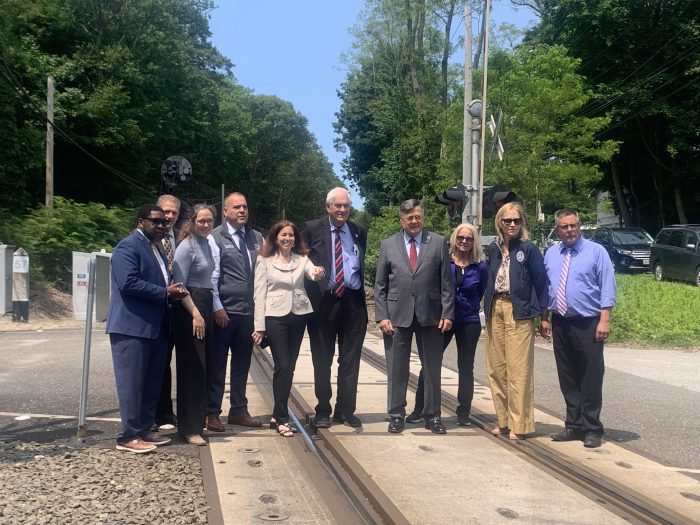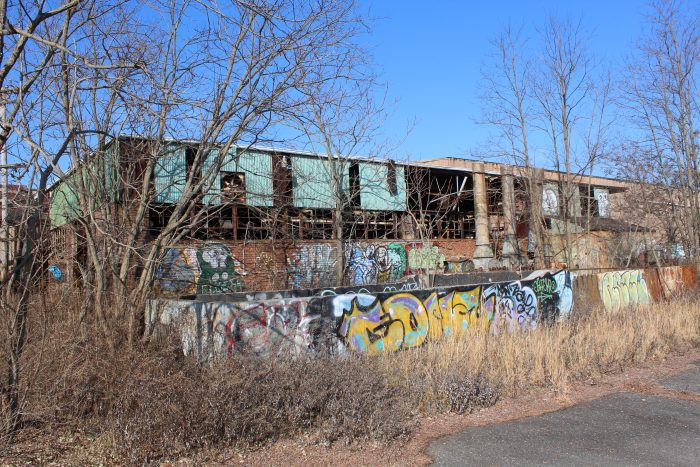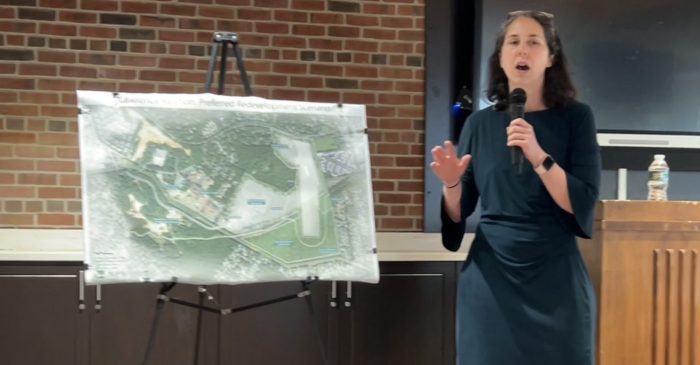The expansion and modernization of public rail infrastructure in Suffolk County is essential to addressing the region’s long-term transportation needs. This legislation facilitates such development by directing the Department of Transportation (DOT) to grant a permanent access and construction easement to the Metropolitan Transportation Authority (MTA). The easement will allow the MTA to and utilize a portion of DOT-owned land currently designated as the Setauket-Port Jefferson Station Greenway for the potential development of a railyard, thereby enhancing the capacity, efficiency, and connectivity of public transit in the region. The easement is also necessary to further New York State’s green transit goals, better allowing for the electrification of the LIRR’s Port Jefferson branch.To ensure that this easement does not interfere with existing transportation priorities, the bill expressly preserves the DOT’s retained rights to carry out any future realignment of New York State Route 25A, including through the construction of a bridge over the Greenway. It further mandates cooperation between the DOT and the MTA to enable both projects to proceed concurrently without operational conflict. By establishing clear terms for coexistence and requiring timely execution of the easement agreement, the legislation provides a structured legal framework that advances public transit objectives while maintaining the integrity of state infrastructure planning.
Assemblywoman Rebecca Kassay shared, “I became aware of the importance of this project when I was serving as a Port Jefferson Village Trustee. I was compelled to serve from a higher office in part to help overcome bureaucratic stalemates like this one. The economic, environmental, and community benefits of this project can not be understated and I am very proud to have introduced, sponsored, and passed this legislation that delivers a key solution to moving forward with the modernization and electrification of the Port Jefferson LIRR line.”
In 2023, the Suffolk County Landbank Corporation and the MTA entered into a contract to transfer a portion of the site to the MTA for $10—a strategic move to support LIRR modernization. In early June 2025, Assemblywoman Kassay gathered with elected officials at all levels of government, government agencies, and community organizations to call upon New York State to resolve the ongoing bureaucratic impasse. A disagreement between these two state agencies threatened to derail a critical component of the community-backed redevelopment plan.
Following this press conference, the DOT reached out to Assemblywoman Kassay to discuss the “Furthering Rail Transit in Suffolk County Act”. In a race against the clock, with the Assembly and Senate session concluding mid-June, Assemblywoman Kassay worked swiftly to move the bill along with the DOT, MTA, Assembly Speaker Heastie, Governor Hochul’s staff, Senator Anthony Palumbo, Senator Monica Martinez, and Suffolk County Executive Ed Romaine and county staff.
This bipartisan coalition is driven by the regional and state-wide significance of the redevelopment of the Lawrence Aviation site. The Port Jefferson Branch of the Long Island Rail Road (LIRR), which serves approximately 30% of Suffolk County’s population—including faculty and students at SUNY Stony Brook, the county’s largest employer—has long needed modernization. According to the American Public Transportation Association, every $1 invested in public transportation yields a $5 economic return.
In Albany, various legislation and policies have been adopted in an effort to reduce carbon emissions throughout New York. Since taking office in January, Assemblywoman Kassay has highlighted the importance of this local opportunity to ensure future electrification of the Port Jefferson Branch, shifting its trains off of diesel fuel. transformative investments in regional transit infrastructure, improvements to service on one of Suffolk County’s most heavily used diesel rail lines, and relief from traffic congestion by offering better commuter rail options for residents.
Assemblywoman Rebecca Kassay shared, “As a freshman member in the New York State legislature, I applaud the groups and individuals who have worked tirelessly for over a decade to clean up the former Lawrence Aviation Industries (LAI) site in Port Jefferson Station and engage the community in a vision and plan for its future. I join Suffolk County government officials and the county’s Department of Economic Development and Planning in their work to prioritize public input over profit in the reimagining of the former superfund site.”
“For many years two state agencies ─ the Department of Transportation and the Long Island Rail Road ─ have not been able to agree to accept Suffolk County’s generous offer of land that would eliminate the dangerous at-grade rail crossing on New York State Route 25A in Upper Port and eliminate unhealthy locomotive fumes by relocating the terminus of the railroad and ultimately enabling its electrification. Although this inaction has paralyzed regional transportation planning and suppressed the economic vitality of every community served by the North Line, Assemblywoman Kassay’s legislation appears to have turned the corner on this morass. Her problem-solving skill is a breakthrough that has profound positive potential to improve the quality of life and health of everyone who lives here.” Suffolk County Legislator Steven C. Englebright (D-Setauket)
New York State Senator Anthony Palumbo said, “The passage of this legislation is critically important for Suffolk County residents and would remove an obstacle in our efforts to make Lawrence Aviation a transportation hub for our region. The redevelopment of this site is the key to electrifying lines to eastern Suffolk and will ensure a more reliable and cleaner transportation system, helping to reduce traffic congestion, especially in the busy summer months. I am proud of our work in getting this bill through the legislature and the continued efforts of the local community to move this project forward.”
“This legislation is a significant public victory,” said Adrienne Esposito, Executive Director, Citizens Campaign for the Environment. “This is the best $10 the government has ever spent. The easement will allow us to modernize the LIRR, reduce truck traffic, and reduce harmful air pollution. We are extremely appreciative of Assemblywoman Rebecca Kassay and Senator Anthony Palumbo for their hard work and dedication in getting it through the legislature. Now, we need the Governor to sign the bill so we can meet our transportation challenges for the future.”
Carmine Inserra, President of the Three Village Chamber of Commerce shared, “The Furthering Rail Transit in Suffolk County Act (A8560A) passing is a huge win for the north shore of Long Island! It paves the way for cleaner, more frequent transportation for all communities along the MTA’s Port Jefferson Branch. It will also offer better public access to the Three Village Historic area and New York State’s flagship university, SUNY Stony Brook (which is also the largest employer on Long Island). Thank you to all the local governmental officials and both business & civic leaders for your support! We appreciate everyone working together on something that benefits us all!”








